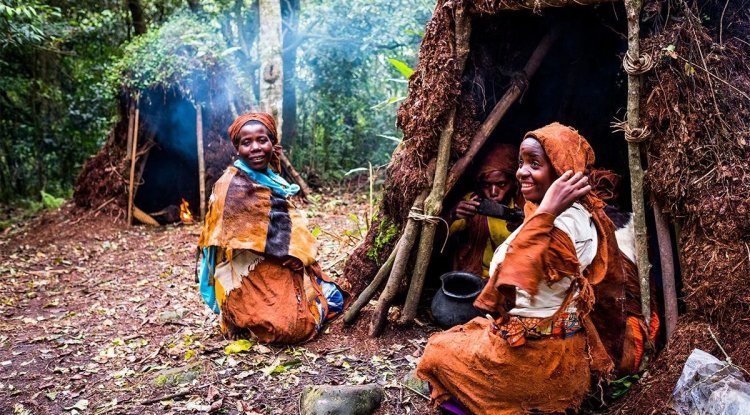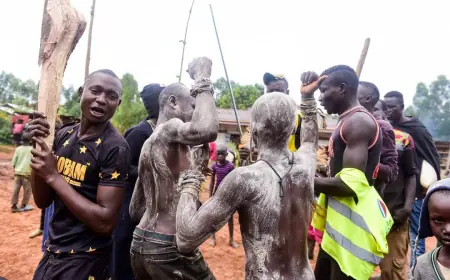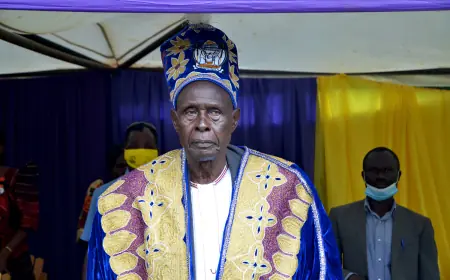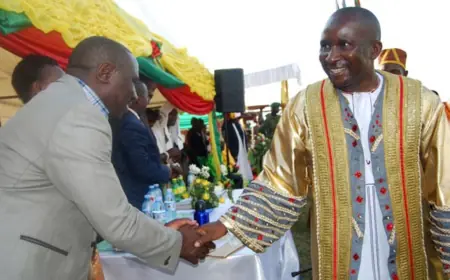The Bafumbira
The historical Ankole and Kigezi neighborhoods, which border Rwanda, are home to the Banyarwanda or Bafumbira. However, they have spread to many locations in Uganda.
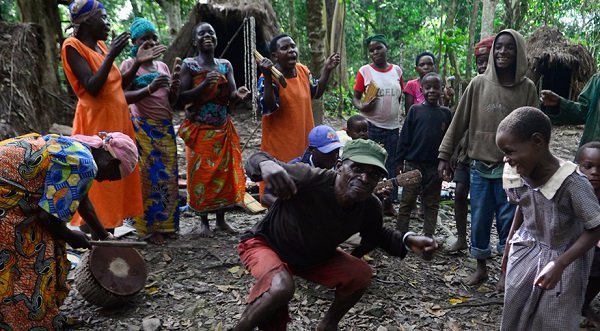
They have the same moral principles as the Banyarwanda of Rwanda. The Bafumbira people are those who live in Kisoro District, which is in the extreme southwest of Uganda. This is the only neighborhood where Banyarwanda people predominate. Rwanda is to their south, and Zaire lies to their west. Their country is chilly and rugged. Up until the boundary changes in 1910, Bafumbira was a part of Rwanda.
The Origin of Bafumbira
The Bahutu, Batutsi, and Batwa are the three indigenous groups that make up the Bafumbira, listed in decreasing order of numerical superiority. They are essentially Banyarwanda and speak Kinyarwanda.
Along with the Bambuti of Mount Rwenzori and the Ndorobo of Kenya, the Batwa are said to have been among the earliest people to live in East Africa. They don't have a routine, established way of life. According to legend, the Bahuutu were the second group to reach Bufumbira. The Bantu group known as the Bahutu is thought to have left the Congo around the year 1000. From the northeast, they arrived in Rwanda.
Before A.D. 1500, the Batutsi then appeared. The story of Batutsi's origins is made up. Some claim they came from the northern Tanzanian city of Karagwe. Others claim that their ancestors may have come from Egypt, Ethiopia, or Somalia. This is due to the Batutsi's resemblance to the Galla and the Somali.
Language of Bafumbira
"Rufumbira" is the name of the tongue used by the Bafumbira. Kinyarwanda has a dialect known as Rufumbira. Accents are what make a difference.
The Bafumbira Social-set-up
In Bufumbira and other Banyarwanda settlements, the Batwa were a minority. They were the most despised, primarily because so little was known about their civilization. It is said that no one has ever visited a Mutwa's burial, and no one is aware of the dates and details of the Batwa people's wedding rituals. The Bahutu and Batutsi's constant pleading with them intensified the scorn and disrespect shown to the Batwa. The Batwa who inhabited the Chunya Bamboo forest reserve were masters at using bows and arrows to hunt. They subsisted off of hunting and gathering, consuming both their own catch and those which the Bahuutu and the Batutsi ignored. They were also known for eating mutton.
Bahuutu and Batutsi had comparable cultural traits. The bulk of Bahutu did not consume sheep or fowl, and neither did the Batutsi. They delivered these to the Batwa. Additionally, goat flesh was not permitted to be consumed by Bahutu and Batutsi women.
Clans
The Bafumbira are organized into clans similarly to the Baganda. There are eight main clans there. The clans were split according to a variety of totems, including various species of birds, plants, and animals. The hill that each clan occupied served as an identifier. The Bafumbira do not give their kids clan-related names. Abasindi, Abachaba, Abasinga, Abakyondo, Abazigaba, Abagahe, Abagesera, Abasigi, Abagiri, Abagara, Abarihira, Abungura, and Abatundu are some of the clans.
Marriage
The Batutsi married later than the Batwa and Bahuutu did. Intermarriages between the Batwa, Bahuutu, and Bahima were uncommon despite the apparent absence of taboos barring romantic partnerships.
Intermarriage between close relatives was outlawed among the Bahutu and Batutsi on the grounds that the progeny would be weak and susceptible to psychic attacks. Boys in the Batutsi community were frequently pressured into marriage before they were prepared. Their mothers and aunts kept a careful eye on the girls. Virginity was prized highly. Pregnancies before marriage were undesirable. If a girl became pregnant before her marriage, she would be cast into the forest and left at the mercy of wild animals.
In the past, parents would plan their children's weddings. However, there was also something called Gufata or Gaturura. Gafuta was a legalized form of forced marriage in which a boy would kidnap a girl and force her to become his wife. There was a concept among the Bahuutu called ukwijana. The girl had to slip away from her parents and go to a boy's house to get married because this was a pre-arranged marriage. Every time a female became pregnant before marriage, this would happen. Gufuta and ukwijana were both socially acceptable but unworthy of praise.
Cows and goats were used as the bride's payment. Exorbitant bride riches were paid if a girl was coerced into marriage. On the other hand, the bride price varied depending on how a girl arrived at the boy's house to get married. The bride's riches would be modest if the girl made the decision to leave, but extravagant if the boy made the proposal. After that, plans for the wedding would be made. Local sorghum beer and banana beer were served on the wedding day. The wedding festivities began late at night and lasted until early in the morning.
Traditional dances were conducted on the days of weddings. The men would sing and narrate famous historical events as the women ululated. They danced in pairs. The men would jump as well. Drums and harps were used as the musical instruments. All of the groups were characterized by clapping. The Bahuutu, like the Bakiga, played the zither, although the Batwa were renowned harpists. The males danced in groups called intore, which were typically more than ten people, while the girls sang and danced in couples among the Batutsi.
It was acceptable to practice polygamy. It not only raised the man's prestige but also expanded his family. They claimed that monogamy was equivalent to marrying one's mother. Divorce was also acceptable and permitted in cases of intoxication, cruel treatment, adultery, gluttony, reluctance, or incapacity to engage in sex, among other unfavorable circumstances.
The naming of children in Bufumbira
Depending on a family situation or the current scenario, the Bafumbira name their offspring. A child was given the name "Senzoga" if they were born during a time when beer was being brewed. The infant was given the name "Senzira" if it was born while the father was traveling. The baby was given the name "Nyirabakire" if there was plenty of food in the home at the time of birth.
Burial
Burial is practiced by the Bahuutu and Batutsi. There would be four days of mourning for anyone over the age of eighteen. There would be no digging or other manual labor during the period of grief. The heir to the deceased, where appropriate, was placed during an unique ceremony known as Guta igiti (casting off the ash), which was held at dawn on the fourth day.
Economy
The Batwa had a very straightforward economy. They were reliant on foraging and hunting. They did not excavate, so they placed the least value on land. They would trade wild animal skins, trophies, bows, and arrows for wheat and alcohol from the Bahuutu and the Batutsi. Some Batwa would only beg for money to survive. Their huts were equally basic as the Bambuti's. They used to conceal their private areas with straightforward skin. The basketry and pottery skills of the Batwa are still excellent.
Possession of a Mutwa was a symbol of prosperity and security among the Bahutu and the Batutsi. Cattle was the primary economic indicator among the Bahutu and the Batutsi. As a result of their large number of cow herds, the Batutsi were highly esteemed. Land was not individually owned by people because the King owned all of it. On every piece of ground within reach of his dwelling, a person could dig or pasture animals.
They dug with a longer, wider hoe. Sorghum, peas, and beans were the main crops. Hoes, knives, and other tools were produced on a modest scale by ironsmiths in the culture. They utilized an umuhoro suckle to harvest sorghum. Men cut the sorghum down, and women separated the grain from the stalks with iron knives called indiga. The produce was kept in granaries made of bamboo that were built within the property.
Bahuutu made excellent beer. They used sorghum to make beer. Umuramba, wutunda, nyirakabisi, and amarwa were some of the names given to the regional drinks. It would be known as inturire if it was combined with honey. For the elderly and chiefs, inturire was a drink. Public drinking was prohibited for the women. Actually, the dregs were their prerogative. The elderly smoked unprocessed tobacco in pipes. Opium might also be smoked by Batwa in addition to tobacco.
Dwellings
Homesteads were where the Bahuutu and Batutsi resided. Their hut had a spherical shape, was grass-thatched, and was white-sand washed. Unlike the Batwa, the Bahutu and Batutsi men were in charge of building and marinating the dwellings. All of the families were patrilineal and extended. Single clans tended to congregate in the same area.
Sports and personal adornments.
Hunting was the Bafumbira people's favorite sport. They utilized bows and arrows, hunting nets, spears, clubs, and dogs with bells around their necks while they went hunting. Other popular activities, particularly among the Batutsi, included wrestling, jumping, and the board game mweso. It had the name igisoro.
The Bahuutu used tiny iron knives to mark their faces. This was done to alleviate headaches. For identifying purposes, the Batutsi left one little mark on their faces. The Batwa went a step further than other tribes by embellishing their arms. Women frequently wore bangles and neck jewelry.
Religious beleifs of bafumbira
An ultimate entity known as Imana or Rurema, was revered by the Bahuutu and Batutsi. Imana was revered as the source of all life and thought to communicate through the mediums of Nyabinghi or Lyangombe Biheko. Nyabinghi and Biheko received sacrifices, and each family had an indaro shrine. The family head would present sorghum, bread, and beer to the gods depending on the situation, because Indaro was regarded as a very sacred area. In the event that the family head passed away, all of the responsibilities for offering sacrifices to the gods in the family indaro would fall on the first-born or first son.
Food
The Bafumbira work in agriculture. Sorghum is the main meal they eat. Sorghum grains can be picked either fresh or dry and eaten raw or cooked. They can also be pounded into flour, which is used to produce a variety of drinks. They also grow legumes, primarily beans and potatoes, that thrive in volcanic soil. The staples include maize, beans, peas, Irish potatoes, and sweet potatoes.
Utensils
The traditional household tools included imitiba (large bamboo store baskets within the house), wooden stools, spears, knives, bows, and arrows, as well as baskets, winnowing trays, grinding stones, and a variety of pottery items. Additionally, cow milkers kept ibisabo (churning gourds), inkongoro, and various milk containers. Mats made of marsh grass that were attractively adorned and stitched with strings were used to cover the interior spaces. During wedding rituals and feasts, these mats served as the women's favorite seats. Huge mats called ibirago, which are used to dry produce like sorghum, could also be found.
Political set-up of the bafumbira
The Bahutu, the Batwa , and other communities were traditionally ruled by the Batutsi aristocracy. It was genetic to be a leader. The King, Umwami, served as the head of state. The chiefs of the land (Umunyabutaka) and cattle or grass (Umunyamukenke) provided him with assistance. Subordinate chiefs known as Ibisonga and Abakoresha aided the land chief in turn. Professional Batutsi, Bahutu, and Batwa soldiers made up the King's standing army (intore).
A Muhutu would provide clientage, on the verge of servitude, to a Mututsi under the ubuhake clientele system, in exchange for being granted a cow. A system of blood brotherhood was used to strengthen ties within the society. It involved sucking each other's blood from the naval and swearing to treat one another like true brothers. The parties to the contract would then exchange presents with one another.
Judicial system of bafumbira
Wizards and thieves were strongly condemned. Every time they were captured, they would be whipped or speared to death. A lady would also be given poison to drink if she poisoned someone to death. Ordinarily, civil disputes would be resolved by family leaders and elders. Male fighting was dismissed while female fighting was condemned. A traditional proverb said, "Those who fight are the ones who have their tummies full."
Every time there was a family argument that resulted in a divorce, the elders were consulted. If the husband was found guilty, he would redeem his wife by giving the woman's family a pot of beer and a goat. If the woman was found guilty, she would get verbal reprimands. A woman was not fined because it was feared that it would upset the family dynamic.
What's Your Reaction?
 Like
13
Like
13
 Dislike
0
Dislike
0
 Love
3
Love
3
 Funny
0
Funny
0
 Angry
0
Angry
0
 Sad
0
Sad
0
 Wow
2
Wow
2





























































